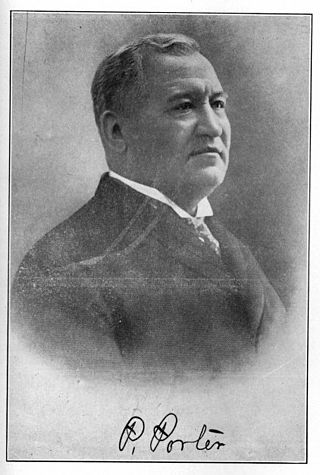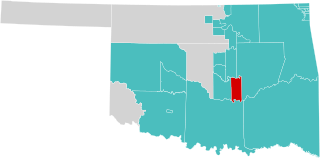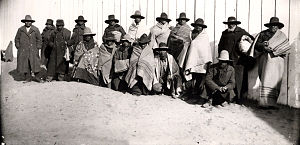
The term Five Civilized Tribes was applied by the United States government in the early federal period of the history of the United States to the five major Native American nations in the Southeast: the Cherokee, Chickasaw, Choctaw, Muscogee (Creek), and Seminoles. White Americans classified them as "civilized" because they had adopted attributes of the Anglo-American culture.
The Dawes Rolls were created by the United States Dawes Commission. The commission was authorized by United States Congress in 1893 to execute the General Allotment Act of 1887.

The Oklahoma Indian Welfare Act of 1936 is a United States federal law that extended the 1934 Wheeler-Howard or Indian Reorganization Act to include those tribes within the boundaries of the state of Oklahoma. The purpose of these acts were to rebuild Indian tribal societies, return land to the tribes, enable tribes to rebuild their governments, and emphasize Native culture. These Acts were developed by John Collier, Commissioner of Indian Affairs from 1933 to 1945, who wanted to change federal Indian policy from the "twin evils" of allotment and assimilation, and support Indian self-government.
The American Dawes Commission, named for its first chairman Henry L. Dawes, was authorized under a rider to an Indian Office appropriation bill, March 3, 1893. Its purpose was to convince the Five Civilized Tribes to agree to cede tribal title of Indian lands, and adopt the policy of dividing tribal lands into individual allotments that was enacted for other tribes as the Dawes Act of 1887. In November 1893, President Grover Cleveland appointed Dawes as chairman, and Meridith H. Kidd and Archibald S. McKennon as members.

Pleasant Porter, was an American Indian statesman and the last elected Principal Chief of the Creek Nation, serving from 1899 until his death.
Lighthorse is an official or colloquial name for the police forces of federally recognized tribes in the United States. Some tribal governments officially refer to their police as Lighthorse while others do not. Historically, the term referred to the Five Civilized Tribes of the United States' mounted police forces. The Lighthorse were generally organized into companies and assigned to different districts. Perhaps the most famous were the Cherokee Lighthorsemen which had their origins in Georgia.

The Choctaw Nation of Oklahoma is a Native American reservation occupying portions of southeastern Oklahoma in the United States. At roughly 6,952,960 acres, it is the second-largest reservation in area after the Navajo, exceeding that of the seven smallest U.S. states. The seat of government is located in Durant, Oklahoma.

Choctaw Country is the Oklahoma Department of Tourism and Recreation's official tourism designation for Southeast Oklahoma. The name was previously Kiamichi Country until changed in honor of the Choctaw Nation headquartered there. The current definition of Choctaw Country includes ten counties, being Coal, Atoka, Bryan, Choctaw, McCurtain, Pushmataha, Le Flore, Latimer, Haskell, and Pittsburg counties. The department created the term as one of six designated travel regions within the state. However, other definitions of Southeastern Oklahoma may include additional counties.

The Muscogee Nation, or Muscogee (Creek) Nation, is a federally recognized Native American tribe based in the U.S. state of Oklahoma. The nation descends from the historic Muscogee Confederacy, a large group of indigenous peoples of the Southeastern Woodlands. They commonly refer to themselves as Este Mvskokvlke. Historically, they were often referred to by European Americans as one of the Five Civilized Tribes of the American Southeast.

The Choctaw Freedmen are former enslaved Africans, Afro-Indigenous, and African Americans who were emancipated and granted citizenship in the Choctaw Nation after the Civil War, according to the tribe's new peace treaty of 1866 with the United States. The term also applies to their contemporary descendants.

Chitto Harjo was a leader and orator among the traditionalists in the Muscogee Creek Nation in Indian Territory at the turn of the 20th century. He resisted changes which the US government and local leaders wanted to impose to achieve statehood for what became Oklahoma. These included extinguishing tribal governments and civic institutions and breaking up communal lands into allotments to individual households, with United States sales of the "surplus" to European-American and other settlers. He was the leader of the Crazy Snake Rebellion on March 25, 1909 in Oklahoma. At the time this was called the last "Indian uprising".

During the American Civil War, most of what is now the U.S. state of Oklahoma was designated as the Indian Territory. It served as an unorganized region that had been set aside specifically for Native American tribes and was occupied mostly by tribes which had been removed from their ancestral lands in the Southeastern United States following the Indian Removal Act of 1830. As part of the Trans-Mississippi Theater, the Indian Territory was the scene of numerous skirmishes and seven officially recognized battles involving both Native American units allied with the Confederate States of America and Native Americans loyal to the United States government, as well as other Union and Confederate troops.

The Seminole Nation of Oklahoma is a federally recognized Native American tribe based in the U.S. state of Oklahoma. It is the largest of the three federally recognized Seminole governments, which include the Seminole Tribe of Florida and the Miccosukee Tribe of Indians of Florida. Its citizens are descendants of the approximately 3,000 Seminoles who were forcibly removed from Florida to Indian Territory, along with 800 Black Seminoles, after the Second Seminole War. The Seminole Nation of Oklahoma is headquartered in Wewoka within Seminole County, Oklahoma. Of 18,800 enrolled tribal citizens, 13,533 live in Oklahoma. The tribe began to revive its government in 1936 under the Indian Reorganization Act. While its reservation was originally larger, today the tribal reservation and jurisdictional area covers Seminole County, Oklahoma, within which it has a variety of properties.

Benjamin Harjo Jr. was a Native American painter and printmaker based in Oklahoma.
Creek Freedmen is a term for emancipated Creeks of African descent who were slaves of Muscogee Creek tribal members before 1866. They were emancipated under the tribe's 1866 treaty with the United States following the American Civil War, during which the Creek Nation had allied with the Confederate States of America. Freedmen who wished to stay in the Creek Nation in Indian Territory, with whom they often had blood relatives, were to be granted full citizenship in the Creek Nation. Many of the African Americans had removed with the Creek from the American Southeast in the 1830s, and lived and worked the land since then in Indian Territory.
The Four Mothers Society or Four Mothers Nation is a religious, political, and traditionalist organization of Muscogee, Cherokee, Choctaw and Chickasaw people, as well as the Natchez people enrolled in these tribes, in Oklahoma. Four Mothers Society ceremonial grounds remain active today.
On the eve of the American Civil War in 1861, a significant number of Indigenous peoples of the Americas had been relocated from the Southeastern United States to Indian Territory, west of the Mississippi. The inhabitants of the eastern part of the Indian Territory, the Five Civilized Tribes, were suzerain nations with established tribal governments, well established cultures, and legal systems that allowed for slavery. Before European Contact these tribes were generally matriarchial societies, with agriculture being the primary economic pursuit. The bulk of the tribes lived in towns with planned streets, residential and public areas. The people were ruled by complex hereditary chiefdoms of varying size and complexity with high levels of military organization.
Hickory Ground, also known as Otciapofa is an historic Upper Muscogee Creek tribal town and an archaeological site in Elmore County, Alabama, United States, near Wetumpka. It is known as Oce Vpofa in the Muscogee language; the name derives from oche-ub'hickory' and po-fau'among'. It is best known for serving as the last capital of the National Council of the Creek Nation, prior to the tribe being moved to the Indian Territory in the 1830s. It was added to the National Register of Historic Places on March 10, 1980.
Samuel Checote (1819–1884) (Muscogee) was a political leader, military veteran, and a Methodist preacher in the Creek Nation, Indian Territory. He served two terms as the first principal chief of the tribe to be elected under their new constitution created after the American Civil War. He had to deal with continuing tensions among his people, as traditionalists opposed assimilation to European-American ways.
Sharp v. Murphy, 591 U.S. ___ (2020), was a Supreme Court of the United States case of whether Congress disestablished the Muscogee (Creek) Nation reservation. After holding the case from the 2018 term, the case was decided on July 9, 2020, in a per curiam decision following McGirt v. Oklahoma that, for the purposes of the Major Crimes Act, the reservations were never disestablished and remain Indian country.












